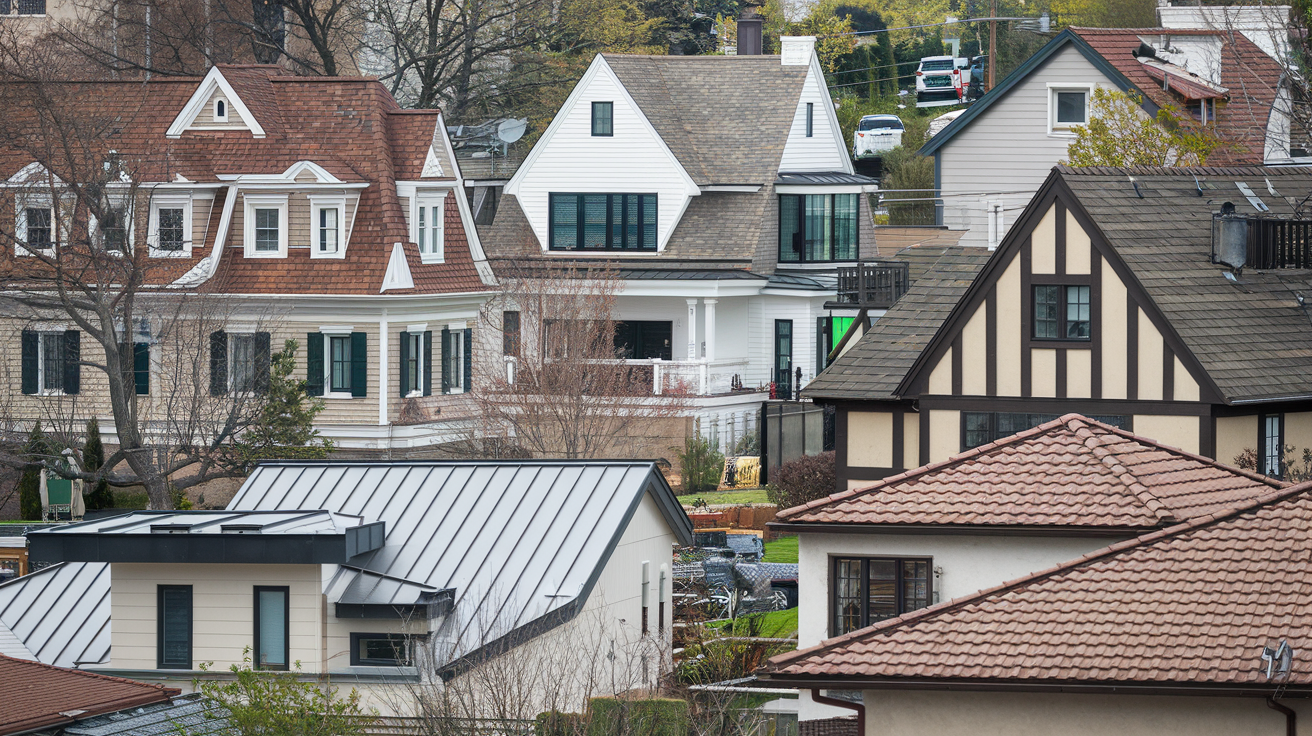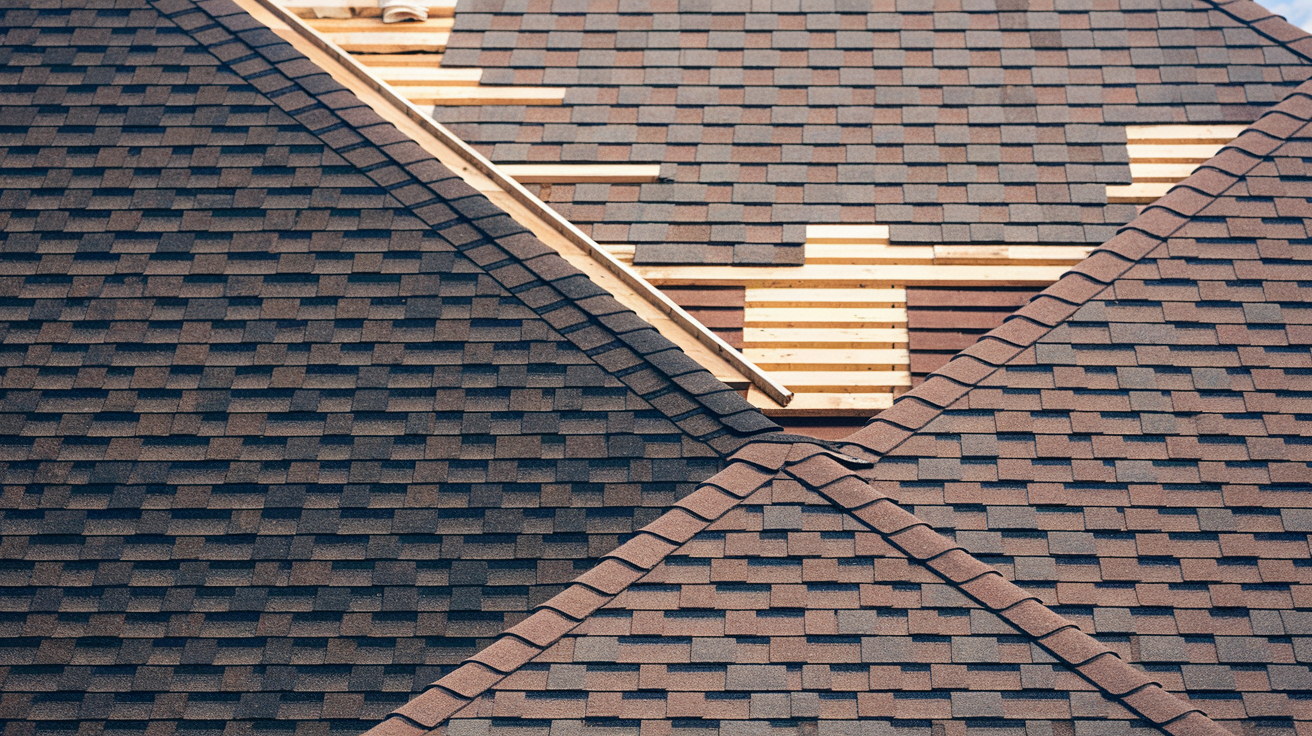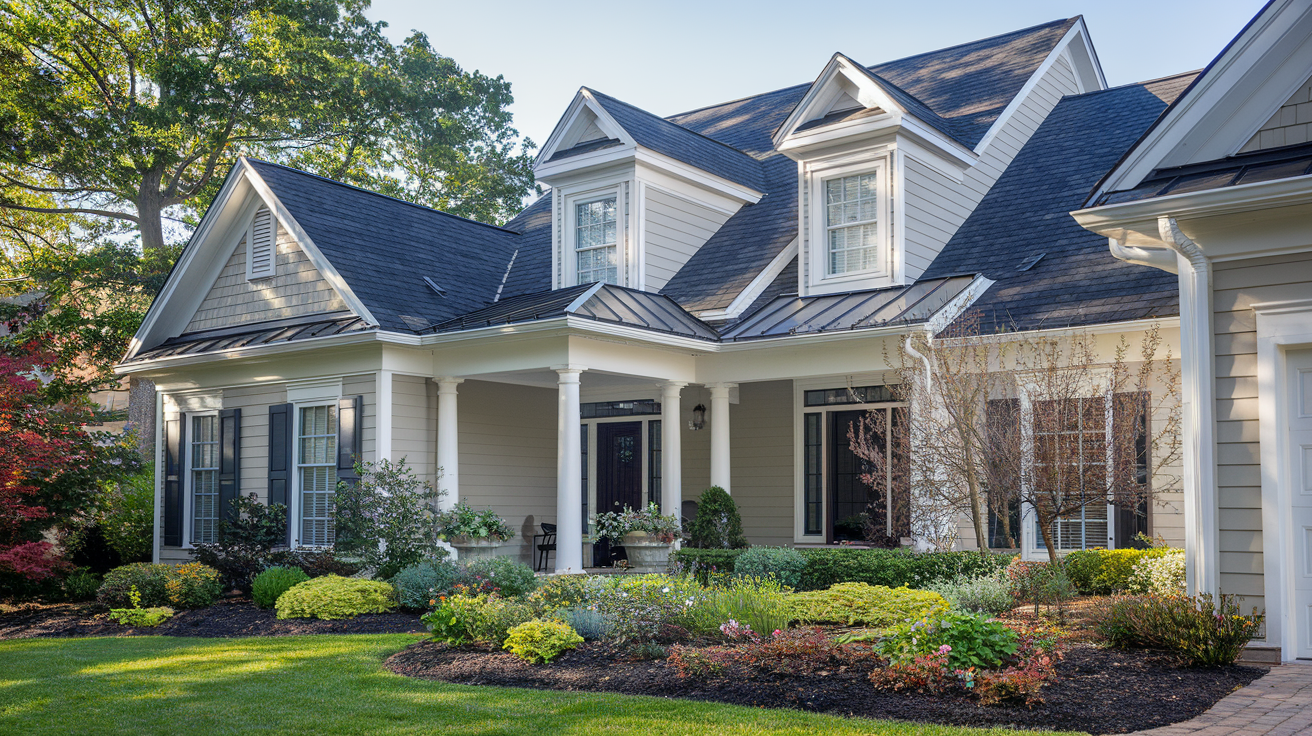Ultimate Guide: Choose the Perfect Roof for Your Home's Style (2024)
Is your roof showing signs of wear, or are you planning a new home? Selecting the right roof is one of the most crucial decisions you'll make as a homeowner. With the average roof replacement costing $9,191 and potentially affecting your home's value by up to 40%, choosing the right type of roof for your home's architectural style and specific needs is essential.
Your roof does more than just protect your home from the elements. It's a defining feature that can enhance or diminish your property's curb appeal, energy efficiency, and resale value. Whether you're dealing with a Colonial home that demands traditional aesthetics or a modern design that calls for contemporary solutions, understanding how to match your roof to your home's architecture is crucial.
In this comprehensive guide, you'll discover how to select the perfect roof that balances style, durability, and functionality. We'll explore everything from popular materials like asphalt shingles, which dominate 75% of residential roofing projects, to emerging options like metal roofs, which can last up to 80 years. You'll learn about cost considerations, climate factors, and how different architectural styles influence your roofing choices.
- Understanding Your Home's Architectural Style
- Types of Roofing Materials
- Matching Roof Types to Architectural Styles
- Assessing Your Specific Needs
- Conclusion: Making the Final Decision
Understanding Your Home's Architectural Style
Choosing the right roof involves more than just cost and durability. It's about understanding your home's architectural style. The roof is a key design element that enhances curb appeal and function. Matching your roof to your home's style creates a cohesive and attractive look, whether you're building or renovating. This section explores how architectural styles influence roof design choices.
Common Architectural Styles and Their Characteristics
Different architectural styles have unique features:
Colonial Homes: Often have symmetrical designs and steep roofs. These homes typically suit traditional materials like asphalt shingles, the most common roofing material used in approximately 75% of roofing projects (source: Homeowners). Asphalt shingle roofs last between 20 years for 3-tab shingles and longer for architectural shingles.
Modern Homes: Feature clean lines and flat or low-sloped roofs, often using materials like metal or concrete. Metal roofs offer exceptional longevity, lasting 40-80 years, but have a higher upfront cost than asphalt shingles.
Tudor Homes: With their steep gable roofs and decorative timbering, need materials that handle complex angles and weather well.
Mediterranean Homes: Usually have low-pitched tile roofs, reflecting their warm-climate origins.
Understanding these style characteristics helps homeowners make informed roofing decisions. For help assessing your current roof, consider our Get Your Roof Assessment.

How Architecture Influences Roof Design Choices
A home's architecture greatly impacts roofing material and design choices. The roof must complement the home's aesthetic and meet its functional needs:
Steeply Pitched Roofs: Common in Victorian or Gothic Revival styles, often use slate or asphalt shingles for durability and weather protection. An average roof lasts 25-50 years, depending on the material and type.
Flat or Low-Sloped Roofs: Often seen in modern designs, typically use metal or rubber membranes for drainage and energy efficiency.
Climate Considerations: Heavy snow or intense sun requires specific designs for optimal performance.
Aligning roof design with architecture and climate creates a roof that is both beautiful and functional. To learn more about roof maintenance and make informed decisions, explore our detailed guide.
| Roof Type | Material | Typical Lifespan |
|---|---|---|
| Steeply Pitched | Slate, Asphalt Shingles | 25-50 years |
| Flat or Low-Sloped | Metal, Rubber Membranes | 20-40 years |
Types of Roofing Materials
Choosing the right roofing material is crucial for both the aesthetic appeal and functionality of your home. Each material offers unique characteristics suited to different architectural styles and climates. This section explores common roofing materials, highlighting their pros and cons to inform your decision. Considering a new roof? Get Your Roof Assessment to determine the best fit for your home.
Asphalt Shingles: Market Dominance and Versatility
Asphalt shingles are the most popular roofing material in North America. In 2020, they held approximately 64% of the residential market (source: U.S. roofing data, 2020). This popularity stems from their affordability, durability, and diverse styles and colors.
Cost and Lifespan
Asphalt shingles are a cost-effective choice, with installation ranging from $4.50 to $12.25 per square foot. This equates to $450 to $1,225 per roofing square (100 square feet). They typically last 20 to 30 years, depending on maintenance and local climate. Learn more about roof maintenance to maximize the lifespan of your roof.
Styles
Asphalt shingles come in various styles, including three-tab and architectural. Three-tab shingles comprise 42% of all roofs, while architectural shingles represent 33%. Three-tab shingles offer a budget-friendly option, while architectural shingles provide a more textured, dimensional appearance.

Metal Roofing: Growth and Longevity
Metal roofing is steadily gaining popularity, with an annual growth rate of 8% (source: BuilderOnline). This rise is driven by its exceptional longevity, durability, and energy efficiency.
Lifespan and Cost
Metal roofs are incredibly long-lasting, often enduring 40 to 80 years—significantly longer than asphalt shingles. Some even last 70 years or more. While metal roofs typically have a higher upfront cost than asphalt shingles, they offer long-term savings.
Benefits
Metal roofs require less maintenance and can lower energy bills by reflecting heat away from the building. This makes them a sustainable and cost-effective choice over time.
| Metal Roofing Benefits | Description |
|---|---|
| Longevity | Lasts 40-80 years |
| Energy Efficiency | Reflects heat, lowers energy bills |
| Low Maintenance | Requires minimal upkeep |
Tile Roofing: Traditional Elegance and Strength
Tile roofing provides a classic, elegant aesthetic, often seen on traditional and Mediterranean-style homes. However, tile can also be adapted to contemporary designs.
Durability and Lifespan
Made from clay or concrete, tile roofs are highly durable and weather-resistant. They boast a lifespan of 50 to 100 years, making them one of the most durable roofing options. While tile has a higher initial cost than asphalt, it offers excellent insulation and requires minimal maintenance.
Wood Shakes and Shingles: Rustic Charm and Insulation
Wood shakes and shingles offer a rustic charm, often gracing historic or country-style homes. Both are made from cedar, redwood, or pine, providing natural insulation.
Shakes vs. Shingles
Shakes are thicker and have a more textured, hand-split look, while shingles are thinner and more uniform. Wood roofing generally lasts 20 to 30 years, depending on wood quality and environmental factors.
Maintenance
Wood roofs require regular maintenance, including treatments to prevent rot and insect infestation, to ensure their longevity. Despite this, their aesthetic and insulation benefits remain attractive to homeowners seeking a natural look.
Matching Roof Types to Architectural Styles
Choosing the right roof isn't just about how it looks. It's also about making sure it fits your home's style and your needs. With so many choices, picking the right roof can feel overwhelming. Knowing the best options for different home styles can make it easier. Let's look at the best roofing choices for traditional, modern, and historic homes.
Traditional Homes: Best Roof Options for Cohesion
Traditional homes often have classic features. These homes need roofing materials that match their design. Asphalt shingles are a popular choice because they're versatile and affordable. They make up about 60% of the residential roofing market. These shingles come in many colors and styles, making them a good fit for Colonial, Victorian, and Cape Cod homes.
Long-Lasting Traditional Roofing Options
Want a roof that lasts longer? Metal roofs are becoming more popular because they're durable. They're growing at a rate of about 8% each year. Metal roofs offer a sleek, classic look that can improve a traditional home. They also last a long time (50+ years, compared to 12-25 years for asphalt shingles).
Considering the Costs of Traditional Roofing
Asphalt shingles typically cost between $80 and $800 per roofing square (100 square feet). This means a typical roof could cost anywhere from $2,000 to $16,500. Asphalt shingles are usually cheaper upfront, while metal roofs cost more initially. Considering replacing your asphalt shingle roof? 3-tab shingles last about 20 years, while architectural shingles last longer. You can learn more about roof maintenance to make informed decisions about your roof.
Modern and Contemporary Homes: Innovative Roofing Solutions
Modern homes often have clean lines and modern designs. They need roofs that match this style. Metal roofing is a great choice. It offers a sleek, minimalist look that works well with modern architecture. These roofs are durable and energy-efficient. They reflect heat away from your home, which can lower your cooling bills.
How Cool Roofs Work
How does this work? A cool roof, like some metal roofs, reflects more sunlight than a standard roof. It absorbs less solar energy, which keeps your home cooler. Green roofs and solar roofs are also gaining popularity. These eco-friendly options not only look good but also help the environment and save energy.
Sustainable Roofing Options
What are these options exactly? Green roofs use plants on the roof. This can also help with insulation. Solar roofs use solar panels to potentially generate electricity. These trends show a growing interest in sustainable and smart roofing technologies for the future. Ready to explore your options? Get Your Roof Assessment to see what's best for your home.

Historic Homes: Maintaining Integrity with Appropriate Roofing
When choosing a roof for a historic home, it's important to maintain its history. You need materials that match the original style while also meeting today's standards. Wood shingles and shakes are traditional choices that offer an authentic look for historic homes. They provide a classic, rustic feel. However, they need regular upkeep to prevent damage.
Alternative Roofing for Historic Homes
What are some other options? Slate is another great choice. It's known for lasting a long time and having a classic look. Slate is often used in historic homes to preserve their original style. While slate can be more expensive, it's very durable and looks great, making it a good investment for a historic home.
Planning for Roof Replacement in Historic Homes
Need a new roof soon? An average roof lasts 25-50 years, depending on the material and quality. For example, the two most common asphalt shingle types, three-tab and architectural, represent 42% and 33% of all roofs, respectively. Replacing a roof costs about $9,191 on average. This average lifespan includes many types of roofs, including asphalt shingles, which are used in roughly 75% of roofing projects. Get expert advice. Get Your Roof Assessment to help protect your historic home.
| Historic Roofing Material | Lifespan | Maintenance Level |
|---|---|---|
| Wood Shingles/Shakes | 20-30 years | High |
| Slate | 50+ years | Low |
Assessing Your Specific Needs
Choosing the right roofing material involves considering your specific needs, from local climate to budget and energy efficiency. Understanding these factors ensures your roof complements your home's architecture and suits your lifestyle. This section guides you through these considerations, helping you make an informed decision that balances functionality, cost, and sustainability.
Climate Considerations: Adapting to Regional Weather
Your region's climate is key to choosing the right roofing material. Areas with extreme weather like heavy snow, high winds, or intense heat need tough materials. Metal roofs, for example, are very durable and reflect most of the sun's energy, making them suitable for hot climates. A metal roof can reach 160°F (71°C). However, it reflects most sunlight and releases only about a quarter of the absorbed heat, keeping the building cooler. Cool roofs also reflect more sunlight and absorb less solar energy, lowering building temperatures and potentially reducing energy bills in warmer areas. Consider local climate patterns when selecting your roofing material for optimal longevity and performance. Regional factors like climate, building styles, and economic conditions influence the roofing materials market. Some materials may be more available or affordable in certain regions.
Considering Wind Resistance
High winds can damage roofs, so choose a material that can handle your area's typical wind speeds. Get Your Roof Assessment to determine the best wind-resistant roofing option for your home.
Budget Constraints: Cost Analysis of Roofing Materials
Budget is a primary factor in choosing roofing materials, as costs vary significantly. Asphalt shingles, dominating 60% of the residential roofing market, are known for affordability and aesthetic appeal. Professionally installed asphalt shingles typically last 25 to 30 years. Installation costs between $4.50 and $12.25 per square foot, plus labor costs of $2.00 to $3.50 per square foot. Therefore, the total cost, including labor, could range from $6.50 to $15.75 per square foot. Metal roofs have a higher initial cost but offer superior longevity, lasting 40 to 80 years, potentially reducing long-term expenses. Balancing initial investment with lifespan and maintenance costs is essential. Factor in potential damage from natural disasters or installation issues when choosing a material. Learn more about roof maintenance to understand long-term costs.
Material Costs vs. Lifespan
Consider the lifespan of different materials. While some are cheaper upfront, they may need replacing sooner. A longer lifespan can save money in the long run.
Energy Efficiency: Impact of Roofing on Sustainability
Energy efficiency is a growing concern for homeowners. Roofing materials significantly impact a home's energy performance. Metal roofs are energy-efficient, reflecting heat and lowering cooling costs in warmer climates. Both metal and asphalt shingles offer energy efficiency, but specific product features influence performance. Cool roofs maximize reflectivity, reducing heat absorption and maintaining lower indoor temperatures. These can include metal and asphalt shingle options. Energy-efficient roofing benefits sustainability and can lead to long-term cost savings. Evaluate long-term benefits and calculate the payback period by comparing installation costs with potential energy savings.
Long-Term Energy Savings
Choosing an energy-efficient roof can result in significant savings on your energy bills over time. This can offset the higher initial cost of some materials.
Conclusion: Making the Final Decision
Choosing the right roof involves balancing aesthetics, function, and cost. Think about not just the price tag, but also how long each material will last and what it offers. Asphalt shingles are a common choice because they're affordable and easy to install. They make up about 60% of the residential roofing market. This is because they are durable, cost-effective, and look good. That means about 6 out of every 10 homes have asphalt shingle roofs. Professionally installed asphalt shingles typically last 25 to 30 years, making them a reliable option. If you want a roof that lasts even longer, metal roofs can last 40 to 80 years, but they cost more upfront. This is much longer than the 20-year lifespan of typical asphalt shingles. If you choose 3-tab asphalt shingles instead of architectural shingles, they typically last about 20 years. The best roof for your home depends on your needs and where you live. For example, asphalt shingles have been common in the Southeast, but metal roofs are becoming more popular there. To help you make the right choice, consider getting a Get Your Roof Assessment.
Consulting Professionals for Personalized Guidance
Talking to roofing professionals can give you valuable advice specific to your home and its location. They can look at things like the slope of your roof, the weather in your area, and local building codes. This ensures your new roof looks good and works well. Experts can help you choose materials that are right for your roof's slope, whether it's steep or not so steep. Some materials work better on certain slopes than others. They can also suggest the newest roofing trends and technologies to make your home more energy-efficient and eco-friendly. One growing trend is smart roofing technology. These systems can track energy use and find leaks. Some smart roofs can even change the ventilation based on the weather. Talking to professionals gives you expert advice so you can choose wisely and maybe even save money down the road. They can also help you understand how long different roofing materials last and how much it costs to replace them. To learn more about roof maintenance and make informed decisions, explore our resources.
Ensuring Longevity: Maintenance and Future-Proofing Your Roof
After you get a new roof, regular upkeep is key to making it last. Regular checks and quick repairs can stop small problems from getting worse and costing you more. This helps your roof stay in great shape for decades. You should get your roof checked about once a year, but how often depends on the roofing material. This lets professionals find problems early, like small damage or loose shingles. You can also think about the future by exploring new roofing materials and technologies. Smart roofing systems can make your home more energy-efficient, and sustainable materials are better for the environment. You don't always have to replace your whole roof. Some eco-friendly choices, like solar panels, can go on top of your current roof. Things like storms or problems with the initial installation can shorten a roof's life and require repairs or replacement. When choosing a material, consider balancing the upfront cost with how long it will last. By taking care of your roof and staying up-to-date with new technology, you can enjoy a strong, efficient, and attractive roof for years to come.
Disclaimer: This blog post is intended for informational purposes only and should not be considered professional roofing advice. Always consult with qualified roofing contractors and insurance professionals for specific guidance regarding your individual circumstances.
